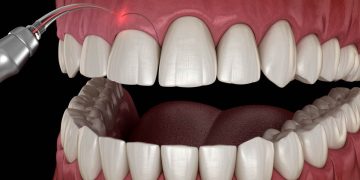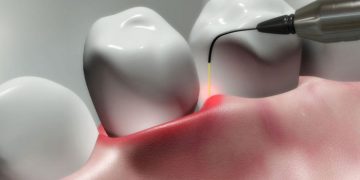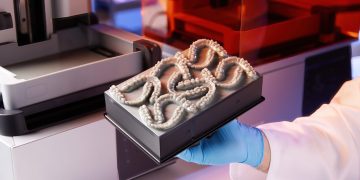Dental implants have become one of the most important technologies in modern dentistry, offering a solution to the problem of missing teeth for many patients. With the advancement of technology, dental implant techniques have matured, and their range of applications has continuously expanded. Implants not only restore the function of missing teeth but also significantly improve the aesthetic appearance. Compared to traditional dentures and bridges, dental implants offer more advantages, such as greater comfort, a more natural appearance, and longer-lasting results.
This article will provide a detailed discussion on dental implant technology, covering the basic principles, technological developments, surgical process, types of implants, success rates, and maintenance and care. The aim is to help readers understand dental implant technology comprehensively and make informed decisions regarding their oral health.
1. The Basic Principle of Dental Implants
A dental implant, also known as a “tooth implant,” is a surgical procedure in which an artificial tooth root (typically made of titanium or other biocompatible materials) is placed into the jawbone, providing a foundation for the installation of a dental prosthesis to restore tooth function and appearance. The concept of dental implants was pioneered in the 1950s by Swedish scientist Per-Ingvar Brånemark. During his research on bone healing, Brånemark discovered that titanium could naturally integrate with bone tissue. This discovery laid the foundation for the development of modern dental implant technology.
The core idea behind dental implants is to insert an artificial tooth root into the jawbone, allowing it to integrate with the bone and provide a stable foundation for the restoration of the missing tooth. Unlike traditional bridges and dentures, dental implants do not rely on adjacent healthy teeth, avoiding damage to existing teeth and offering a more durable and comfortable solution.
2. Technological Development of Dental Implants
2.1 Early Development (1950s to 1970s)
The origins of dental implants can be traced back to 1952 when Swedish scientist Per-Ingvar Brånemark discovered that titanium could bond with bone tissue in a process known as “osseointegration.” This groundbreaking discovery laid the foundation for the development of dental implants. During the 1970s, titanium implants were gradually introduced, and clinical studies showed promising results, which led to wider acceptance of dental implants, especially in Western countries.
2.2 Maturity and Standardization (1980s to 1990s)
By the 1980s, dental implant technology had matured. Improvements in the materials and design of implants further enhanced the success rates of implants. Additionally, the procedures involved in implant surgeries were standardized, leading to lower rates of complications and higher success rates.
During this period, many international dental organizations and research institutions recognized the clinical benefits of dental implants, and extensive studies were conducted to assess their long-term outcomes and safety. As the technology advanced, implants began to replace traditional dentures and bridges, becoming the preferred solution for patients seeking to restore chewing function and aesthetics.
2.3 Innovation and Diversification (2000s to Present)
The 21st century has seen a rapid advancement in dental implant technology. With the advent of computer-aided design and manufacturing (CAD/CAM), three-dimensional imaging technologies (such as CBCT), and minimally invasive techniques, dental implant surgeries have become more precise. Recovery times have shortened, and patients experience increased comfort and safety.
Moreover, the variety of implant types and materials has expanded. In addition to traditional titanium implants, new materials such as ceramic implants have emerged, offering a solution to patients with aesthetic concerns. The indications for dental implants have also broadened, making it a more viable option for a wider range of patients.
3. The Dental Implant Surgical Process
The dental implant procedure typically involves several key steps: initial consultation, preoperative assessment, surgery, healing period, and final restoration. The specifics of the procedure can vary depending on the individual patient’s needs, but the overall process follows a general pattern.
3.1 Initial Consultation and Preoperative Assessment
Before undergoing dental implant surgery, patients will undergo a comprehensive oral examination, which includes the assessment of their teeth, gums, and jawbone. Common preoperative evaluations include:
- Panoramic X-rays: These are used to assess the overall health of the teeth and jawbone.
- 3D CT Scans: These scans provide a more accurate assessment of the jawbone’s structure and density, helping to plan the ideal location and size for the implant.
- Gum and Periodontal Health: The dentist will assess the health of the gums to ensure there is no severe periodontal disease.
- General Health Evaluation: The dentist will consider the patient’s overall health, especially for conditions like diabetes or cardiovascular disease, which may affect the success of the surgery.
Based on the evaluation, the dentist will develop a personalized treatment plan.
3.2 Surgical Process
Dental implant surgery is typically divided into two major stages: implant placement and prosthetic restoration.
3.2.1 Stage 1: Implant Placement
Under local anesthesia, the dentist will make a small incision to expose the jawbone, then use specialized instruments to drill a hole into the bone and insert the dental implant (artificial tooth root). Titanium is most commonly used as the material for the implant due to its biocompatibility and ability to integrate with bone tissue.
After the implant is placed, the patient enters a healing phase that typically lasts between 3 to 6 months. During this time, the implant will undergo osseointegration, becoming securely integrated with the surrounding bone.
3.2.2 Stage 2: Prosthetic Restoration
Once the implant has successfully integrated with the bone, the dentist will perform a second procedure to expose the top of the implant and attach a small metal connector called an abutment. This abutment serves as the interface between the implant and the prosthetic tooth. The dentist will then take impressions of the patient’s mouth to create a custom prosthesis (crown, bridge, or denture), which will be placed over the abutment, completing the restoration.
The entire implant process may take anywhere from several months to over a year, depending on the individual patient’s needs.
3.3 Minimally Invasive Implant Techniques
In recent years, minimally invasive implant techniques have gained popularity. These techniques involve smaller incisions, more precise placement, and fewer surgical steps, resulting in less trauma to the surrounding tissues and a faster recovery time. The advantages of minimally invasive implant surgery include:
- Less bleeding: Smaller incisions reduce damage to blood vessels and result in less bleeding.
- Faster recovery: Reduced tissue damage leads to less swelling and discomfort, allowing for a quicker recovery.
- Less pain: With smaller incisions, there is generally less postoperative pain, improving patient comfort.

4. Types of Dental Implants
As dental implant technology advances, the types and materials used for implants have become more diverse, catering to the various needs of different patients. Common types of implants include:
4.1 Single Tooth Implant
Single tooth implants are used to replace a single missing tooth. A single implant is placed into the jawbone and topped with a custom crown, restoring both the function and aesthetics of the missing tooth.
4.2 Multiple Tooth Implants
For patients missing several teeth, multiple implants can be placed to support a set of prosthetic teeth. Unlike traditional bridges, multiple implants avoid the need to damage adjacent healthy teeth and provide greater stability.
4.3 Full Arch Implants
Full arch implants are used to restore an entire set of teeth. A full arch restoration typically involves placing several implants to support a full set of prosthetic teeth, either through fixed or removable solutions.
4.4 Immediate Implants
Immediate implants refer to the process of placing an implant at the same time as extracting a tooth. This method reduces the treatment timeline, and temporary restorations can be installed during the healing period, allowing for faster restoration.
4.5 Ceramic Implants
Ceramic implants, typically made of zirconia, are a newer type of implant material that offers excellent biocompatibility, aesthetic appeal, and corrosion resistance. Ceramic implants are especially suitable for patients who have aesthetic concerns, particularly in the anterior (front) regions.
5. Success Rate and Factors Affecting Dental Implants
While dental implants generally have a high success rate, there are various factors that can affect their long-term success. Research shows that the success rate for dental implants is typically above 95%. However, without proper maintenance, failure rates can increase.
5.1 Factors Affecting the Success of Implants
- Bone Quality and Quantity: The health and density of the jawbone play a crucial role in implant success. Patients with insufficient bone may need bone grafting procedures before implants can be placed.
- Oral Hygiene Habits: Maintaining proper oral hygiene is essential for preventing implant failure due to peri-implant diseases (such as peri-implantitis), which can compromise the implant.
- General Health: Overall health, including conditions like diabetes or osteoporosis, can affect the healing and integration of the implant.
- Surgical Technique and Equipment: The skill of the surgeon and the use of advanced diagnostic and surgical equipment play a significant role in the success of the procedure.
5.2 Causes of Implant Failure
Although dental implants have a high success rate, failure can still occur due to various factors. Common reasons for implant failure include:
- Failure of Osseointegration: The implant fails to properly integrate with the bone, possibly due to insufficient bone density or health issues affecting healing.
- Infection: Postoperative infections, such as peri-implantitis, can lead to implant failure if not managed properly.
- Implant Loosening or Fracture: Excessive chewing pressure or trauma can cause the implant to loosen or fracture,
leading to failure.
6. Maintenance and Care for Dental Implants
Although dental implants are a highly effective and durable treatment, they still require ongoing maintenance to ensure their long-term success. Proper care helps prevent complications such as infection and implant failure. Key care guidelines include:
- Maintain Good Oral Hygiene: Brush your teeth at least twice a day and use dental floss or interdental brushes to clean between the teeth and around the implant.
- Regular Check-ups: Visit your dentist regularly for check-ups to monitor the stability of the implant and the health of the surrounding gums.
- Avoid Hard Foods: Avoid chewing excessively hard foods that could damage the implant.
- Healthy Diet: Eat a balanced diet, and avoid excessive sugar, which can contribute to oral health problems that may affect the implant.
7. Conclusion
Dental implant technology has significantly improved the quality of dental care and the quality of life for many patients. Through precise surgical techniques and advanced materials, implants are able to restore tooth function and aesthetics. While the technology continues to advance, the choice of treatment should always depend on an individualized assessment from the dentist.
For patients with missing teeth, dental implants are undoubtedly an excellent solution that restores chewing function and enhances aesthetics. However, to ensure the long-term success of the implants, it is crucial to undergo proper preoperative assessments, follow through with postoperative care, and maintain good oral hygiene.













































Discussion about this post